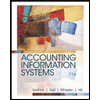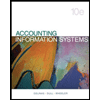
Intermediate Accounting
9th Edition
ISBN: 9781259722660
Author: J. David Spiceland, Mark W. Nelson, Wayne M Thomas
Publisher: McGraw-Hill Education
expand_more
expand_more
format_list_bulleted
Question
Chapter 1, Problem 1.9E
To determine
Financial Accounting Standards Board (FASB): FASB is an independent 7 member board, of accounting professionals overseeing the creation of financial statement. FASB standards are generally known as GAAP.
To Match: The List A with the List B.
Expert Solution & Answer
Want to see the full answer?
Check out a sample textbook solution
Students have asked these similar questions
Carter Inc. had $3,000 of supplies on hand on
January 1. During the year, the company
purchased $4,800 of supplies, and on December
31, determined that only $1,200 of supplies were
still on hand. The adjusting entry for Carter Inc. on
December 31 will include:
a. Debit Supplies $4,800
b. Credit Supplies Expense $6,600
c. Debit Supplies Expense $6,600
d. Debit Supplies Expense $2,800
Hello tutor please provide this question solution general accounting
Provide answer
Chapter 1 Solutions
Intermediate Accounting
Ch. 1 - Prob. 1.1QCh. 1 - What is meant by the phrase efficient allocation...Ch. 1 - Identify two important variables to be considered...Ch. 1 - What must a company do in the long run to be able...Ch. 1 - Prob. 1.5QCh. 1 - Prob. 1.6QCh. 1 - Prob. 1.7QCh. 1 - Prob. 1.8QCh. 1 - Prob. 1.9QCh. 1 - Prob. 1.10Q
Ch. 1 - Prob. 1.11QCh. 1 - Prob. 1.12QCh. 1 - Prob. 1.13QCh. 1 - Prob. 1.14QCh. 1 - Prob. 1.15QCh. 1 - Explain what is meant by: The benefits of...Ch. 1 - Prob. 1.17QCh. 1 - Briefly define the financial accounting elements:...Ch. 1 - Prob. 1.19QCh. 1 - What is the going concern assumption?Ch. 1 - Prob. 1.21QCh. 1 - Prob. 1.22QCh. 1 - What are two advantages to basing the valuation of...Ch. 1 - Describe how revenue recognition relates to...Ch. 1 - What are the four different approaches to...Ch. 1 - In addition to the financial statement elements...Ch. 1 - Briefly describe the inputs that companies should...Ch. 1 - Prob. 1.28QCh. 1 - Prob. 1.29QCh. 1 - Prob. 1.30QCh. 1 - Prob. 1.31QCh. 1 - Prob. 1.32QCh. 1 - Accrual accounting LO12 Cash flows during the...Ch. 1 - Financial statement elements LO17 For each of the...Ch. 1 - Prob. 1.3BECh. 1 - Basic assumptions and principles LO17 through...Ch. 1 - Prob. 1.5BECh. 1 - Prob. 1.6BECh. 1 - Accrual accounting LO12 Listed below are several...Ch. 1 - Accrual accounting LO12 Listed below are several...Ch. 1 - Prob. 1.3ECh. 1 - Prob. 1.4ECh. 1 - Prob. 1.5ECh. 1 - Financial statement elements LO17 For each of the...Ch. 1 - Concepts; terminology; conceptual framework LO17...Ch. 1 - Prob. 1.8ECh. 1 - Prob. 1.9ECh. 1 - Prob. 1.10ECh. 1 - Basic assumptions and principles LO18, LO19...Ch. 1 - Prob. 1.12ECh. 1 - Prob. 1.13ECh. 1 - Prob. 1.14ECh. 1 - Prob. 1.15ECh. 1 - Prob. 1.1BYPCh. 1 - Research Case 12 Accessing SEC information through...Ch. 1 - Prob. 1.3BYPCh. 1 - Prob. 1.4BYPCh. 1 - Ethics Case 18 The auditors responsibility LO14...Ch. 1 - Prob. 1.9BYPCh. 1 - Judgment Case 110 GAAP, comparability, and the...Ch. 1 - Prob. 1.11BYPCh. 1 - Prob. 1.12BYPCh. 1 - Analysis Case 113 Expense recognition LO19...Ch. 1 - Prob. 1.14BYPCh. 1 - Real World Case 115 Elements; disclosures; The...Ch. 1 - Prob. 1.16BYPCh. 1 - Target Case LO19 Target Corporation prepares its...
Knowledge Booster
Similar questions
- Problem related general Accounting 52arrow_forwardSummit Corporation provided the following financial details: Financial Data: Beginning Total Assets: $600,000 Ending Total Assets: $640,000 • Net Income: $125,000 • Tax Rate: 30% Calculate: Return on Total Assets (ROA)arrow_forwardSubject general accountingarrow_forward
- Big Company purchased Small Company for $1,450,000. Small Company had assets with a fair value of $1,150,000, and liabilities with a fair value of $200,000. Use this information to determine the dollar value of good will.arrow_forwardA $2,000 bond issued in 2018 pays $180 in interest each year. What is the current yield on the bond if it can be purchased for $1,500?arrow_forwardQuick answer of this accounting questionsarrow_forward
- Use the following data to find the total direct labor cost variance if the company produced 4,200 units during the period. Direct labor standard (5 hrs. @ $7/hr.): $35 . Actual hours worked: 4,200 • Actual rate per hour: $7.80 a. $10,920 Favorable b. $10,920 Unfavorable c. $18,540 Favorable d. $3,285 Unfavorable e. $114,240 Favorablearrow_forwardThe predetermined overhead rate for Bright Co. is $12, which includes a variable overhead rate of $8 and a fixed overhead rate of $4. The budgeted overhead costs at a normal capacity of 50,000 direct labor hours were divided by the normal capacity of 50,000 hours to arrive at the predetermined overhead rate of $12. The actual overhead for August was $20,000 for variable costs and $15,000 for fixed costs. The standard hours allowed for the product produced in August were 4,000 hours. What is the total overhead variance? A. $20,000 U B. $21,000 F C. $13,000 U D. $23,000 Farrow_forwardAccounting 88arrow_forward
arrow_back_ios
SEE MORE QUESTIONS
arrow_forward_ios
Recommended textbooks for you
 Auditing: A Risk Based-Approach (MindTap Course L...AccountingISBN:9781337619455Author:Karla M Johnstone, Audrey A. Gramling, Larry E. RittenbergPublisher:Cengage Learning
Auditing: A Risk Based-Approach (MindTap Course L...AccountingISBN:9781337619455Author:Karla M Johnstone, Audrey A. Gramling, Larry E. RittenbergPublisher:Cengage Learning Accounting Information SystemsFinanceISBN:9781337552127Author:Ulric J. Gelinas, Richard B. Dull, Patrick Wheeler, Mary Callahan HillPublisher:Cengage Learning
Accounting Information SystemsFinanceISBN:9781337552127Author:Ulric J. Gelinas, Richard B. Dull, Patrick Wheeler, Mary Callahan HillPublisher:Cengage Learning Financial & Managerial AccountingAccountingISBN:9781285866307Author:Carl Warren, James M. Reeve, Jonathan DuchacPublisher:Cengage Learning
Financial & Managerial AccountingAccountingISBN:9781285866307Author:Carl Warren, James M. Reeve, Jonathan DuchacPublisher:Cengage Learning Pkg Acc Infor Systems MS VISIO CDFinanceISBN:9781133935940Author:Ulric J. GelinasPublisher:CENGAGE L
Pkg Acc Infor Systems MS VISIO CDFinanceISBN:9781133935940Author:Ulric J. GelinasPublisher:CENGAGE L

Auditing: A Risk Based-Approach (MindTap Course L...
Accounting
ISBN:9781337619455
Author:Karla M Johnstone, Audrey A. Gramling, Larry E. Rittenberg
Publisher:Cengage Learning

Accounting Information Systems
Finance
ISBN:9781337552127
Author:Ulric J. Gelinas, Richard B. Dull, Patrick Wheeler, Mary Callahan Hill
Publisher:Cengage Learning

Financial & Managerial Accounting
Accounting
ISBN:9781285866307
Author:Carl Warren, James M. Reeve, Jonathan Duchac
Publisher:Cengage Learning

Pkg Acc Infor Systems MS VISIO CD
Finance
ISBN:9781133935940
Author:Ulric J. Gelinas
Publisher:CENGAGE L